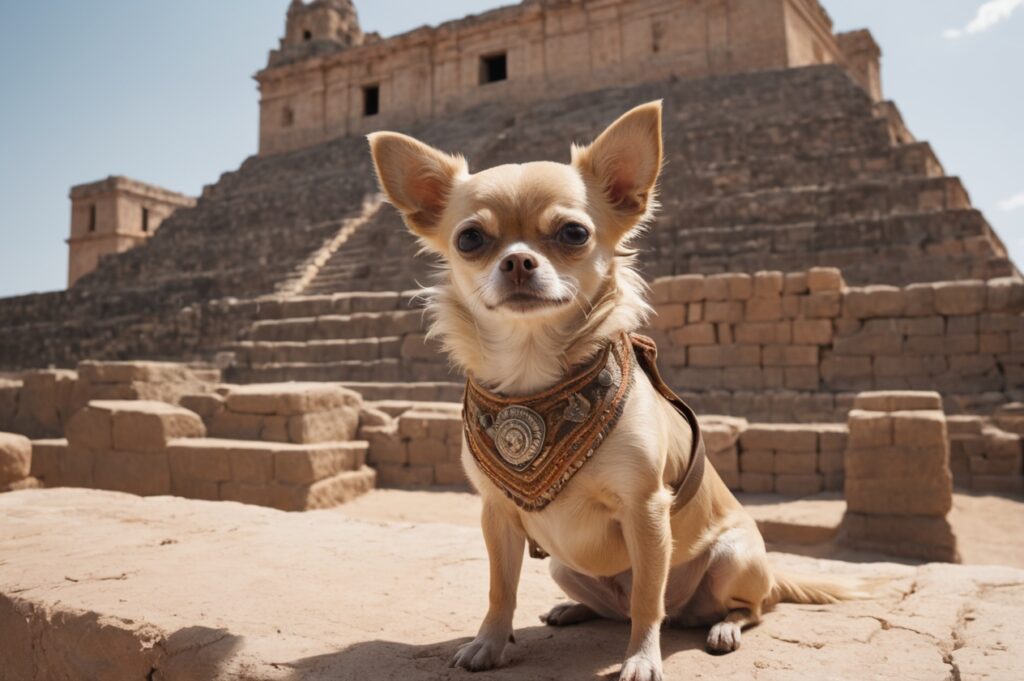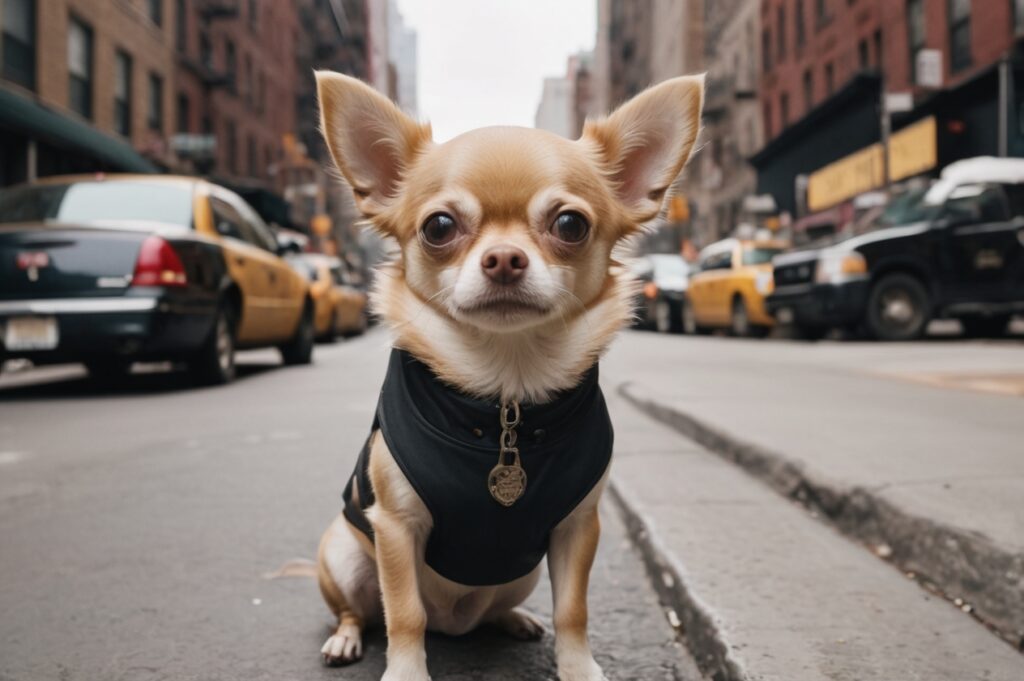The Fascinating History of the Chihuahua: From Ancient Mexico to Today

The Chihuahua, one of the world’s most recognizable dog breeds, has a history that stretches back thousands of years to the ancient civilizations of Mexico. Though small in size, this breed carries with it a rich and fascinating past, intertwined with sacred rituals, cultural practices, and, eventually, its rise to global popularity as a beloved companion. From its mysterious origins to its current status as a media icon and household pet, the Chihuahua’s journey is one filled with intrigue, admiration, and resilience.
In this article, we’ll explore the Chihuahua’s storied history, starting with its ancient roots in Mexico, its introduction to the United States, and its rise in modern pop culture. Through understanding the Chihuahua’s past, we gain a deeper appreciation for the breed’s enduring appeal and the important role it plays in both history and today’s society.
1. Origins of the Chihuahua in Ancient Mexico
The Chihuahua’s story begins in ancient Mexico, where its ancestors roamed the lands of civilizations like the Toltecs, Mayans, and Aztecs. While the breed we know today has undergone significant changes over the centuries, its roots trace back to the Techichi, a small, companion dog favored by the Toltec civilization. This ancient breed played an important role in the culture and beliefs of early Mesoamerican societies.
1.1 Connection to the Techichi
The Chihuahua is believed to be descended from a breed called the Techichi, which dates back as early as the 9th century. The Techichi was a small, mute dog that was revered by the Toltecs, one of the earliest advanced civilizations in Mexico. Unlike modern Chihuahuas, the Techichi was larger and had a heavier build, but it shared the same small stature that would become a defining trait of the Chihuahua.
The Toltecs, who thrived between the 9th and 12th centuries, domesticated the Techichi for various purposes, including companionship and religious rituals. These dogs were often depicted in Toltec art, with carvings and pottery showing their likeness. The Techichi played a significant role in spiritual practices, believed to be a guide for the souls of the dead as they journeyed to the afterlife. This spiritual connection between the Techichi and the afterlife helped cement the breed’s importance in ancient Mexican culture.
1.2 Sacred Status in Aztec and Mayan Culture
The Techichi’s influence extended beyond the Toltecs, into the Aztec and Mayan civilizations. In these cultures, the Techichi maintained its sacred status, revered for its spiritual significance. The Aztecs, who dominated central Mexico from the 14th to the 16th centuries, believed that the Techichi had the power to guide souls through the underworld, a belief that influenced burial practices. It was common for Techichis to be sacrificed and buried with their owners to assist in the afterlife journey.
In addition to its spiritual role, the Techichi was also valued as a companion and was often kept in households. Its small size made it easy to care for, and it became a symbol of status and wealth. For the Mayans, the Techichi’s presence in the household was thought to bring good fortune and protection from evil spirits.
These ancient civilizations laid the foundation for the Chihuahua’s eventual development into the breed we recognize today. The reverence for these small dogs in religious and cultural practices ensured that they remained a central figure in Mesoamerican life, even as empires rose and fell.
1.3 Archaeological Evidence of Early Chihuahuas
Archaeological evidence supports the connection between the Techichi and the modern-day Chihuahua. Excavations in ancient burial sites across Mexico have uncovered the remains of small dogs, including those resembling the Techichi. These findings provide insight into the breed’s long-standing relationship with human societies in Mesoamerica.
In addition to skeletal remains, depictions of small dogs similar to the Techichi have been found in ancient artifacts, including pottery, carvings, and sculptures. These artistic representations offer further proof of the breed’s significance in ancient cultures. In particular, the dogs are often shown in a protective or guiding role, underscoring their spiritual importance.
As the centuries progressed and European colonization reshaped the cultural landscape of Mexico, the Techichi began to evolve, eventually giving rise to the Chihuahua. However, the breed’s ancient roots in Mesoamerican history remain a crucial part of its identity, making the Chihuahua one of the oldest and most culturally significant breeds in the Americas.
2. The Chihuahua’s Journey to the United States

The Chihuahua’s path from ancient Mexico to the modern world took a pivotal turn in the late 19th century when it was discovered by American travelers. These travelers, intrigued by the breed’s small size and unique appearance, began bringing Chihuahuas back to the United States, where the breed quickly gained popularity. The Chihuahua’s rise in the U.S. marked the beginning of its transformation from a sacred companion in ancient Mexico to a beloved pet in modern homes.
2.1 Discovery by American Travelers in Mexico
The Chihuahua first gained attention in the late 1800s when American tourists visiting Mexico encountered the breed in the northern state of Chihuahua, from which the breed eventually took its name. These small dogs, which were often found in rural villages, were unlike any other breed seen in the U.S. at the time. Their tiny size and distinct features captivated American visitors, and many began bringing Chihuahuas back home.
One of the earliest documented imports of Chihuahuas to the U.S. occurred in the 1880s, when American breeders began purchasing the dogs from Mexican merchants. These early Chihuahuas were often described as “pocket-sized” dogs, small enough to fit in the palm of a hand, making them an instant novelty. Their small stature and charming personalities helped the breed gain a foothold in the American pet market.
2.2 Gaining Popularity in the U.S.
Once the Chihuahua arrived in the U.S., its popularity began to grow rapidly, particularly among dog enthusiasts and breeders. The breed’s uniqueness, combined with its manageable size, made it appealing to people looking for small companion dogs. As more Chihuahuas were imported and bred in the U.S., the breed began to attract attention at dog shows, where its size and agility helped it stand out from larger breeds.
By the early 20th century, the Chihuahua had become a fashionable pet among the upper class, with many wealthy individuals acquiring the breed as a status symbol. Its small size made it ideal for city living, and it soon became a favorite in urban environments, where space was limited. The breed’s growing popularity in the U.S. set the stage for its eventual recognition by major kennel clubs.
2.3 The Chihuahua’s Official Recognition by Kennel Clubs
In 1904, the Chihuahua was officially recognized by the American Kennel Club (AKC), solidifying its status as a legitimate breed in the United States. The first Chihuahua to be registered with the AKC was a dog named Midget, who helped establish the breed’s presence in the world of dog shows. With AKC recognition, the Chihuahua’s popularity continued to rise, and breeders began to focus on refining the breed’s characteristics to meet show standards.
Throughout the 20th century, the Chihuahua’s presence in dog shows grew, with breeders working to improve the breed’s conformation, temperament, and overall quality. The breed’s success in the show ring helped further boost its reputation, and the Chihuahua quickly became a favorite among dog enthusiasts across the country. Today, the Chihuahua remains one of the most popular small breeds in the U.S., thanks to its rich history, distinctive appearance, and charming personality.
3. The Chihuahua in Pop Culture and Media

As the Chihuahua continued to gain popularity in the United States, it became much more than just a household pet—it evolved into a cultural icon. The breed’s small stature, lively personality, and distinctive appearance made it a natural fit for media exposure. From celebrity endorsements to starring roles in commercials and films, the Chihuahua cemented its status as one of the most recognizable and beloved dog breeds in the world.
3.1 Celebrity Endorsements and Iconic Owners
One of the factors that contributed to the Chihuahua’s rise in popularity was its association with celebrities and high-profile individuals. Throughout the 20th century, various actors, musicians, and other public figures were frequently seen with their Chihuahuas, elevating the breed’s status as a fashionable companion. Celebrities like Marilyn Monroe, Paris Hilton, and Madonna all famously owned Chihuahuas, showcasing the breed as both a status symbol and a loving pet.
Paris Hilton’s Chihuahua, Tinkerbell, became one of the most famous celebrity pets of the early 2000s, regularly appearing with Hilton in the media and playing a pivotal role in the Chihuahua’s surge in popularity during that era. The visibility of the breed in the hands of well-known personalities helped catapult it into the mainstream, turning the Chihuahua into a must-have companion for dog lovers everywhere.
3.2 The Taco Bell Chihuahua and Media Exposure
One of the most iconic moments in Chihuahua history came in the late 1990s, when the breed became the face of a hugely successful advertising campaign for Taco Bell. The “Taco Bell Chihuahua,” voiced by Carlos Alazraqui, became a cultural phenomenon, with the dog’s catchphrase “Yo quiero Taco Bell” (I want Taco Bell) becoming instantly recognizable.
This advertising campaign not only boosted sales for Taco Bell but also propelled the Chihuahua into the global spotlight. The Taco Bell Chihuahua’s lovable personality and memorable antics helped solidify the breed’s status as a cultural icon, cementing its place in media history. Though the campaign eventually ended, the Chihuahua’s association with the Taco Bell brand left an enduring legacy that still resonates with the breed’s fans today.
3.3 The Chihuahua’s Role in Movies and TV Shows
The Chihuahua’s popularity in pop culture wasn’t limited to commercials and celebrity endorsements. The breed has also played key roles in numerous movies and television shows, further cementing its place as a pop culture staple. Films such as Beverly Hills Chihuahua and Legally Blonde featured Chihuahuas as central characters, showcasing their intelligence, charm, and vibrant personalities.
In Legally Blonde, the Chihuahua Bruiser was an integral part of Reese Witherspoon’s character’s life, adding both comic relief and emotional depth to the story. The film’s success introduced the Chihuahua to a new generation of dog lovers and reinforced the breed’s appeal in mainstream media. These representations in movies and TV helped shape public perception of Chihuahuas as feisty, loyal, and adorable companions.
4. The Modern-Day Chihuahua: Popularity and Challenges

Today, the Chihuahua remains one of the most popular dog breeds in the world. Its small size, portability, and affectionate nature make it an ideal companion for people living in urban environments. However, with its widespread popularity comes new challenges, particularly in terms of health and ethical breeding practices. While Chihuahuas continue to win the hearts of many, breeders and owners must be mindful of the responsibilities that come with caring for such a unique breed.
4.1 Chihuahua Popularity as a Companion Dog
The Chihuahua’s compact size, combined with its lively and affectionate personality, has made it a favorite among dog lovers worldwide. Chihuahuas are especially popular in apartments and cities, where space is limited, and they are well-suited to modern lifestyles. Despite their small size, Chihuahuas are known for their bravery and loyalty, often forming deep bonds with their owners.
As more people seek small, low-maintenance pets, the Chihuahua continues to be in high demand. Its adaptability to various living environments, coupled with its long lifespan, makes it an excellent choice for families, singles, and seniors alike. The breed’s widespread appeal ensures its place as one of the top companion dogs in many countries.
4.2 Health and Genetic Concerns
Despite their popularity, Chihuahuas are not without their health challenges. Due to their small size and purebred status, Chihuahuas are prone to certain genetic conditions. Common health issues in the breed include patellar luxation, dental problems, heart conditions, and eye disorders. Responsible breeders focus on improving the health and genetic diversity of the breed to minimize these risks.
It’s crucial for prospective owners to work with reputable breeders who prioritize health testing and responsible breeding practices. Regular vet checkups, a proper diet, and careful attention to dental health can help Chihuahuas lead long and healthy lives. As the breed continues to grow in popularity, raising awareness about these health issues and promoting responsible breeding is essential to ensuring the well-being of future generations of Chihuahuas.
4.3 The Chihuahua in Rescue and Adoption Efforts
With the Chihuahua’s surge in popularity over the past few decades, an unfortunate consequence has been the rise in Chihuahuas ending up in shelters and rescue organizations. Many people adopt Chihuahuas without fully understanding the commitment required to care for such a small, yet high-energy breed. As a result, there has been an increase in the number of Chihuahuas in need of rehoming, particularly in the United States.
Rescue organizations specializing in Chihuahuas have become an important resource for rehoming these dogs and finding them loving, permanent homes. These groups work tirelessly to educate the public about the breed’s needs and help place rescued Chihuahuas with responsible owners. Adoption efforts play a crucial role in reducing the number of homeless Chihuahuas and ensuring that they are cared for properly.
Conclusion
From its ancient roots in the civilizations of Mexico to its modern-day role as a beloved companion and pop culture icon, the Chihuahua’s history is rich and captivating. Over the centuries, the breed has evolved from a sacred dog revered by the Toltecs and Aztecs to a household favorite recognized for its bold personality and loyal nature. Its journey to the United States and rise in media have solidified the Chihuahua’s place in the hearts of dog lovers worldwide.
While the Chihuahua’s popularity continues to grow, so too does the responsibility to ensure that the breed is bred and cared for ethically. By understanding the breed’s history, health concerns, and cultural significance, we can better appreciate the Chihuahua’s unique place in both the past and present, ensuring that this fascinating breed thrives for generations to come.






